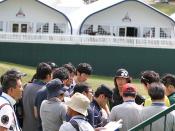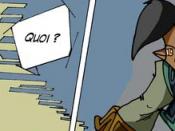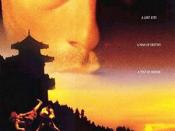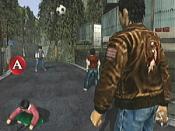Max Cayo Hour 5 Quest Patterns: Shenmue Recounting journeys and adventures, especially those of heroes, is one of the oldest forms of recognized literature. Much the same as it did thousands of years ago; this genre of literature remains one that captures great interest in today's audiences. Aside from being popular, works that follow this journey or voyage model usually share in following a recognizable formula or pattern of events, which is commonly referred to as a quest pattern. This pattern is a series of events, similar in importance to their respective stories, that can be traced to the earliest of stories told by men. One major difference in the stories of today versus those of passed years is the way in which the stories are told. Rather than books alone, the stories of the present are expressed through film as well as television and even video games. One such game is entitled Shenmue, a role-playing game set in modern day Japan.
The game plays upon the story of Ryo Hazuki, a young man who is thrust into a twisting and arduous adventure by a devastating event that would prove life altering for him. Contradictory to the advice of those around him, Ryo embarks on a spiraling journey to bring justice upon the man who murdered his father. As the plot-line of the game plays out it is important to realize that the story contains some of the stages typical to a quest; the hero's call to adventure, the passing of the first threshold, and the appearance of Mystical insight or supernatural gift.
Ryo Hazuki's relatively simple and peaceful day-to-day life would soon come to an end as we find early in the story. We meet Ryo, a high school student, as he is returning to his home in the Japanese town of Yokosuka on a snow filled morning. Ryo's calm demeanor changes as he notices a large black luxury car hastily parked on the grass outside of his house. His father, a very highly regarded martial artist and master of the Hazuki style of martial arts, is engaged in some sort of argument with a strange and rather dark looking man wearing an unusual green embroidered Chinese outfit. Ryo attempts to intervene but is swiftly rendered helpless by two black-suited thugs. The two men speak of some sort of mirror and when they cannot come to a peaceful solution they commence in a fierce battle. Ryo's father is eventually defeated, forced to give up the mysterious mirror, and left to die in Ryo's arms after uttering with his last breath the name of the man in the green suit, "Lan-Di." This commencing event in the story is for the hero, Ryo, the call to adventure stage of the quest pattern. For Ryo, it is the first event that pulls him into the cycle or journey. Ryo, having seen his own father's murder and being able to do nothing, is now determined to bring Lan-Di to Justice and avenge the death of his father. This commencement is marked by the fact that Ryo swears that his father's murder won't go unpunished. In this case, the hero's call to action is from within himself. It is by his own inner motivation and will that Ryo begins the battle for justice and the search for answers surrounding Lan-Di and his purpose. This inner drive is tested as Ryo is cautioned and even begged not to bother with Lan-Di by those closest to him but continues in his quest for revenge. The final characteristic of the call to adventure in a quest is that the hero doesn't fully recognize the call or that it seems accidental. This doesn't fit most literally here, as Ryo does see this as a call to action regarding the quest for vengeance on Lan-Di. However, there is an underlying quest within this story in which Ryo's own courage and strength is tested as he pushes himself closer to realizing the full potential that lies dormant within him. It is this quest that Ryo fails to recognize immediately and that he stumbles into somewhat accidentally. When he begins the search for Lan-Di, Ryo is unaware that he is also beginning a quest within himself that will later reveal itself as equally important.
It isn't long after the call to action at the beginning of the story that we enter the second stage of the quest pattern, the passing of the first threshold. In this stage of the quest, the hero must complete some sort of act signifying the final separation; he can no longer turn back. Ryo goes through this separation during his first confrontation with the local gang, the Mad Angels, who have connections with Lan-Di's cartel. After massing all the information he could about the whereabouts of Lan-Di and his mission, Ryo makes an important decision to continue in his journey by meeting Charlie, one of the prominent gang members in town to try to get closer to Lan-Di. Ryo comes upon Charlie as he sleeps and is forced to restrain Charlie, who pulls a knife on him, to obtain the necessary information. This is the final act of separation, Ryo's actions are irreversible in that the Mad Angels will not soon forget his attack on them and will certainly attempt to deal with the threat at any cost. The passing of the first threshold also marks the beginning of a sort of wandering period for the hero before he or she finishes the adventure. For Ryo, the latter part of his journey is marked by trials and battles as he wanders from place to place growing closer to Lan-Di with every day. This is the period of wandering referred to in this stage of the quest pattern and is imperative to the completion of the quest itself. The final importance of the first threshold is that it indicates the beginning of the trials and ordeals to follow. For Ryo, these trials lie in his progression through the lower ranks of the gang necessary to reach Lan-Di; a progression steeped with fierce battles as well as dead ends and frustrations. By passing that first threshold, Ryo in inherently accepting these ordeals and hardships.
A common and important stage of the quest pattern is one that deals with the introduction of some sort of mystical insight or supernatural gift. In Shenmue, as the quest pattern states, this insight presents itself through a transformation of consciousness; a dream that Ryo repeatedly experiences. In the dream, the image of a mysterious yet innocent Chinese girl appears in different situations throughout the adventure. The girl's purpose is never clearly defined, however it is apparent that she is of some inspirational importance and that she offers some sort of insight into Ryo's future and purpose. The girl is Ling Sha Hua, behind whose childlike demeanor lies the heart and soul of China. It is also foreshadowed that her encounter with Ryo will change her destiny. According to the quest pattern, the mystical insight should instill some sort of faith in spiritual power. Since Ryo cannot recall ever knowing the girl, he is in a way mystified and intrigued by the appearance of her in his own dream. In this case, it is more of a curiosity in spirituality that in a way causes Ryo to continue his quest in order to discover the purpose of the vision. Though not literally implemented, the introduction of this vision could also present a sort of second motivation for Ryo's journey.
Though traditionally, quests and adventures have existed solely in the realm of literature, today the classic quest pattern can be identified in anything from the Internet to video games. As in all examples of the quest pattern, it is important to remember that the stages of the pattern weren't simply made up and then used; but rather discovered as they reappeared in great literature throughout the ages. On exploring an example of the quest pattern it becomes apparent that the reason the pattern repeats itself so frequently is that without some of the basic stages mentioned in the pattern, many adventures simply wouldn't carry the same effect. In the case of Shenmue, the quest pattern is especially recognizable in three stages; the call to adventure, the passing of the first threshold, and the mystical insight or supernatural gift.







